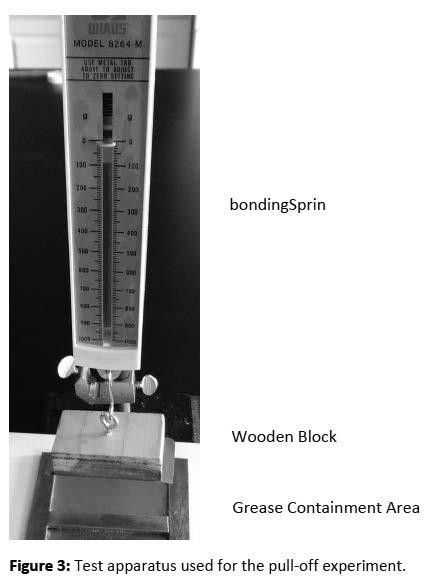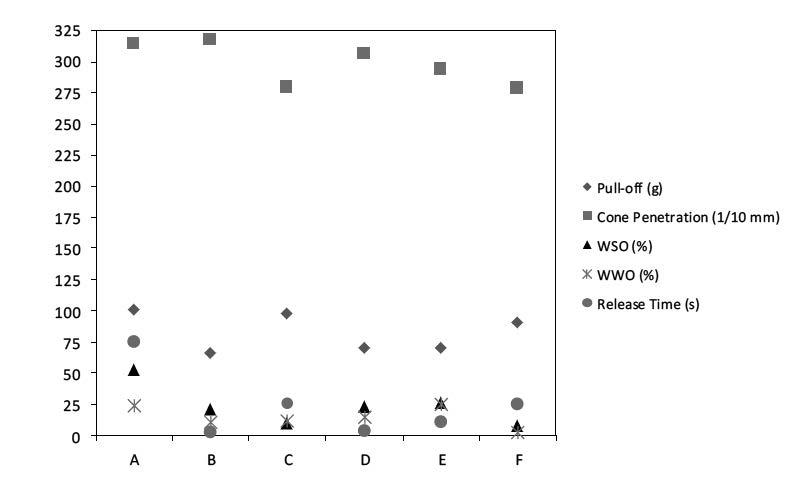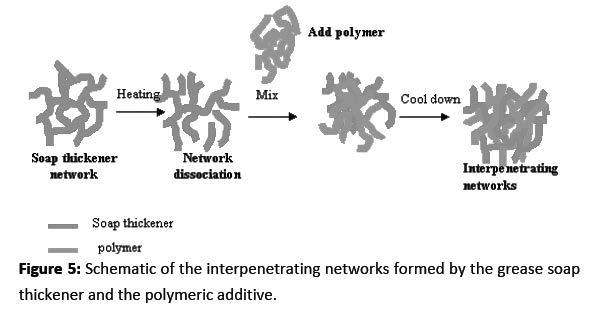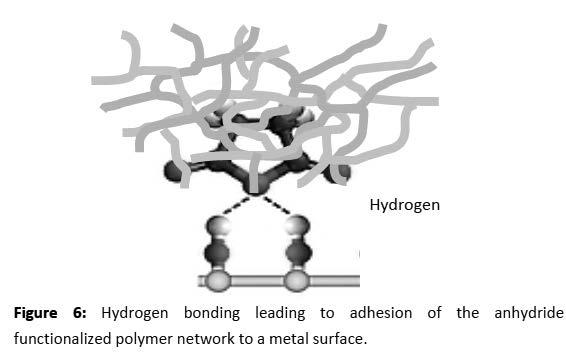
12 minute read
The Adhesiveness of Grease
Daniel M. Vargo
Functional Products Inc. Macedonia, Ohio, U.S.A.
Well-formulated lubricating oils and greases are crucial to the function of modern vehicles and industrial equipment. Unlike oils, greases are semi-solids. Therefore, at a given temperature, greases have a greater ability to stay in place and can provide a much greater film thickness than a lubricating oil. One of the advantages of a grease over lubricating oil is its ability to adhere to a metal part or bearing. This property is called adhesivity. A method has been proposed to determine adhesivity based on the probe tack test (ASTM D2979). This paper focuses on a technique where a metal plate is pulled away from a greased metal plate. The force required to separate the plates is calculated from the known mass as measured by an inexpensive spring scale. The results correlated with other well-known tests such as Cone Penetration (ASTM D217), Water Spray-off (ASTM D4049) and Water Washout (ASTM D1264).
Introduction
Grease is widely used in lubrication applications including roller bearings and low speed gear systems. A lubricating grease comprises three components: base fluid, thickener, and performance additives. A grease is composed of liquid and solid phases. The liquid phase is the base fluid and the solid phase is formed by a network structure of soap molecules or a dispersion of solid particles such as inorganic clays or other thickeners. The solid phase thickener can consist of soap molecules with or without added polymer. The base oil in the grease is immobilized by the soap molecule network structure, resulting in a semi-solid to solid structure. The base oil solubilizes performance additives, including polymers.
The function of the thickener is to provide the gel-like network structure. Generally, the soap thickener is a metallic salt of a long-chain, mono basic, fatty acid, e.g. lithium 12-hydroxystearate. The soap thickener will form interlocked fibers in grease. Incorporating polymers into the grease can further enhance the properties of the grease such as consistency, shear stability, water resistance, adhesion, tackiness, and soap yield. Polymers such as polyethylene, polypropylene, polyisobutylene, halogenated polyethylene, and polymethacrylate are reported to improve the properties of greases.1,, Olefin copolymers (OCPs), Styrene-ethylene-butylene (SEBS) and OCP-anhydride (OCP-A) were studied. Pull-off force was compared to cone penetration, water spray-off, and water wash-out performance in greases containing polymeric additives. In a lithium complex grease an additional component or components are added such as azelaic acid, a dibasic acid. This forms a stiffer, more rigid 3-dimensional structure over that formed using a monobasic acid.
The structure of the polymer has a significant impact on grease properties including thickening efficiency and shear stability. The structure of the polymer determines the overall shape of the molecule. The development of advanced polymerization methods and catalysts allows polymers with a variety of structures to be synthesized. Figure 1 shows various polymer structures that may be obtained. Linear polymers are those with repeat units connected in a single long chain. Branched polymers or comb polymers comprise of structures with a long backbone and multiple side chains. In star polymers or dendrimers, repeat units are arranged radially. The polymers studied in this paper have linear or branched structures.
Tackifiers are typically polymeric additives that impart tack or stringiness to a lubricant. Tack is considered a composite property; the ability of a material to function as a tackifier is determined by its cohesive and adhesive forces, viscosity and other factors such as the molecular weight and concentration of the polymeric additives used in the formulation of such additives. Tackifiers have high cohesive and adhesive forces. High cohesive forces allow the tackifier to remain together as a single mass while high adhesive forces cause the tackifier to remain on the surfaces to be lubricated.
Tack is a composite property and therefore must be measured indirectly. Multiple tests are necessary to fully understand how well a polymeric additive such as a tackifier will perform as a grease additive. The water spray-off and water washout tests quantify only a portion of grease performance, the cohesiveness. The addition of the pull-off test allows an understanding of another important property of a grease tackifier, the adhesiveness. A similar method to determine pull-off force in a lubricant using inexpensive equipment was previously developed.7
Current Test Methods to Measure Tack
Test methods for measuring tack are generally applied to the adhesives market which includes pressure sensitive adhesive tapes and adhesive coatings. Several organizations provide test standards to the adhesives market including the American Society of Testing and Materials (ASTM), the Pressure Sensitive Tape Council (PSTC), the European Association of the Self-Adhesive Labelling Industry (FINAT), the British Standards Institution (BSI) and the Tag and Label Manufactures Institute (TLMI). Test methods currently used for the pressure sensitive tape market include probe tack (ASTM D2979), loop tack (BS EN 1719, TLMI LIB 1/2) and rolling ball tack (ASTM D3121, BS EN 1721), as well as tests for double-sided tapes (BS 7116).8,9
These methods are useful when the adhesive can be coated onto a solid support or a tape and can then be placed in contact with a second surface. The force required to separate the surfaces is then measured and used as an indication of adhesiveness or tackiness. These tests are useful for comparing adhesives to one another but are not suitable for use in the grease industry; these tests measure pressure sensitive tack rather than adhesiveness as it relates to adherence of a grease to a metal part. Cohesion is also an important property that is generally not assessed using test methods designed for use in the adhesives industry. Cohesion provides the string-forming ability of a tackifier solution or a grease due to the interaction of the individual polymer molecules.
A grease should be able to adhere to a surface. This property is determined by factors including internal cohesiveness, surface adhesion, and tackiness or formation of thin string -like grease filaments. By varying the composition of the constituents, the properties of greases can be adjusted. For example, tackifiers containing high molecular weight polymers are added to grease to increase the tackiness or string formation. Most experimental methods to characterize lubricating greases with respect to their cohesive and adhesive properties are empirical in nature.
The cohesiveness of greases has been qualitatively measured by cone penetration10 and oil separation measurements11 while more recently rheological measurements provide further insight.12 Cone penetration measures the consistency or cohesiveness of grease by dropping a cone of known mass into a grease filled trough and recording the penetration depth of the cone. A low depth of penetration indicates stiff grease. The adherence of grease to the substrate is characterized by water spray-off or water washout measurements.12
In the water spray-off test, a greased metallic surface is subjected to direct water spray at elevated temperature and the adherence is determined based on the mass of grease lost over a certain time period.13, 14 Another method used for quantifying adherence is by subjecting greased cylinders to centrifugal forces. Depending on the mass of grease lost, the adhesion strength is ranked.15 In most cases, failure occurs within the grease, which is technically cohesive failure.
Approach- retraction experiments are also used to characterize adherence, cohesion, and tackiness of greases. A greased substrate is moved towards a ball attached to a flexible cantilever. On establishing contact, the greased substrate is moved further until a certain contact load is achieved. On reaching the target contact load, the greased surface is retracted from the ball until complete physical separation occurs.16 The basic technique is analogous to pull-off force experiments done using an atomic force microscope.17 After the approach-retraction cycle, the deflection force is plotted as a function of distance.
This paper presents an empirical method using inexpensive lab equipment to gauge the adhesivity of greases. It can be used as in in-house method to compare one grease to another. The results are correlated with cone penetration, water spray-off and water washout performance.
Adhesion and Cohesion
Cohesion is determined by the attractive forces between the molecules of a substance that tends to hold the substance together. Adhesion is determined by the attractive forces between dissimilar molecules and causes one material to stay in place on another.
Adding a tackifier, such as an ultra-high molecular weight PIB, at approximately 0.05% wt to a lubricant package will tend to increase the cohesiveness and adhesiveness of the lubricant. The cohesive forces within a tackifier result in the string forming ability that is a key component of tackiness. Cohesion also drives the elastic nature of these materials. Greater cohesiveness is required to keep the lubricant from being squeezed out from between surfaces.18 Adhesion is also increased when using a tackifier. Higher adhesiveness is required to make a lubricant stick to surfaces.
Materials
The structures of the polymers used in this study are shown below in Figure 2. The base grease was a Lithium Complex Grade #2 grease with 10% soap content. No additional additives were present. Polymers were incorporated into the base grease by mixing in a Hobart mixer at 90°C. The polymer additives used in this study were in powder, liquid or pellet form. Powdered polymers were added and mixed for 3 hours to ensure complete solubilization of the polymer. Liquid additives, OCP-A and OCP-P were mixed for 1 hour at 90°C. Polymer OCP-B is in pellet form and required longer mixing time and a higher temperature to complete solubilization. For reference, the base grease was heated and stirred using the same process as the samples containing the powdered polymers.
Data for the greases prepared incorporating the polymer additives is summarized in Table 1.

A 36.0 x 76.0 mm piece of sheet steel was attached to a wooden block. A 3mm deep grease containment area having the same dimensions was constructed on another piece of sheet steel. The volume of grease in the containment area for each test run was constant at 8.2 cm3. A screw-eye was attached to the center of the wooden block. Figure 3 on the following page shows the set-up of the test apparatus.
The test grease was added and leveled to the top of the containment area and the wooden block with a metal plate equal in area to the grease containment area was hung from the hand-held spring scale and pulled down and the block was pressed into full contact with the grease. The scale was calibrated such that a pull of 450 grams would be placed on the wooden block when the block and grease were in full contact. When the wooden block was released a steady upward pull of 450 grams was applied to the block, normal to the surface of the grease until the block began to release. The time for the block to be completely released from the grease was recorded. This operation was repeated 5 times for each grease sample and averaged.
Results and Discussion
The data in Figure 4 shows that pull-off force is inversely related to cone penetration. As the grease becomes softer with certain additives it requires less force to remove the mass from the grease. Without any additives the base grease exhibits poor water spray-off performance. For certain additives, SEBS, OCP-A, OCP-B, and OCP-P improved water spray-off values correlate with a greater force required to remove the mass from the grease. This demonstrates that the grease has more adhesivity to the metal plate. The water washout test measures the ability of a grease to be removed from a bearing and is known to not typically correlate well with the water spray-off test. However, for additives OCP-A, OCP-B and OCP-P water washout performance correlates well with water sprayoff performance. It can be understood from the chemical structures shown in Figure 2 that polar acid anhydride allows for greater attraction or adhesivity to the metal surface.
Mechanism
In order to improve the water resistance of grease, the polymer must form a network structure. This network can be formed via physical crosslinking through a crystalline phase (e.g. semi-crystalline OCP), less soluble hard phases (e.g. SEBS), by hydrogen bonding (e.g. anhydride grafted OCP) or by long chain entanglement.
In a simple lithium soap the fiber network structure formed by the soap thickener is reversible. In the mixing process, the network formed by soap thickener is partially dissociated under heating. After cooling, the soap thickener resumes its fiber structure in the presence of the added polymer network. These networks


Figure 4: Grease test results for samples listed in Table 1. Relative to the base grease, A, all of the polymer additives improve the water spray-off performance. However, pull-off force is generally compromised.

interpenetrate as shown in Figure 5. In a complex lithium grease Lorimor has shown that little grease softening (dissociation) occurs therefore an interpenetrating network must form partly by another mechanism.19
Adhesion to a metal surface is driven by the electron rich oxygen of the acid anhydride group hydrogen bonding to the hydroxyl groups generally present on an iron surface, as shown below in Figure 6. As a result, the OCP-A and OCP-B polymers will be part of the interpenetrating network of soap and polymer fibers and be attached to the metal surface through hydrogen bonding. The OCP-P polymer is a proprietary composition that exhibits significantly improved water washout and water spray-off performance. The mechanism attributed to its performance is a combination of multiple interpenetrating networks formed by semicrystalline phase and long chain entanglement linking sites, as well as hydrogen bonding to the metal surface.


Conclusion
Relative to the base grease, all of the polymer additives improve the water spray-off performance. However, pull-off force is generally compromised. Both the pulloff force and water washout performance of a grease are dependent on the cohesiveness of the material. Cohesiveness is partly responsible for the property of a grease known as tack.
The pull-off and water spray-off tests used in this study are relatively quick and simple to perform and require minimal equipment. Potential polymer additives can be qualitatively evaluated and judgments can be made about their performance. Based on the results of this study, a potential polymer additive should have a high pull-off force and excellent water spray-off performance. Combined with other tests, such as mechanical stability and oil separation, a grease additive can be developed and evaluated more readily.





